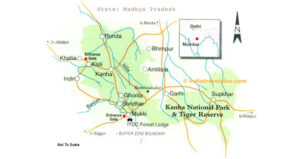Table of Contents
Kanha Tiger Reserve
Kanha Tiger Reserve is one of the most well-known national parks and Tiger Reserves in India, located in the Mandla and Balaghat districts of Madhya Pradesh state in central India. The reserve is spread over an area of approximately 940 square kilometers and is home to a diverse range of flora and fauna.
The history of Kanha Tiger Reserve dates back to 1933 when it was declared a wildlife sanctuary. In 1955, the sanctuary was further extended to include the neighbouring area, and in 1973, it was declared a national park. In 1974, the park was designated as a tiger reserve under the Project Tiger initiative, which was launched to protect the endangered Bengal tiger population in India.
Kanha Tiger Reserve is known for its high density of Bengal tigers, and it is estimated that the park has around 100 tigers. Apart from tigers, the park is home to other large predators such as leopards, wild dogs, and hyenas. Kanha is also known for its population of barasingha, which is a subspecies of deer that is found only in this region.
Read about:
Kanha Tiger Reserve Landscape
The park is divided into four zones, namely Kanha, Kisli, Mukki, and Sarhi, and each zone has a different entry point for visitors.
| S. No. | Name of Zone | Unique Feature |
| 1 | Kanha | The zone with the highest tiger density. |
| 2 | Kisli | Rich in birdlife and scenic beauty. |
| 3 | Mukki | Home to a large population of wild dogs. |
| 4 | Sarhi | The least visited and most secluded zone. |
Kanha Tiger Reserve is located in the central Indian highlands, which is characterized by undulating terrain, with hills and plateaus interspersed with valleys and plains. The reserve is situated on the Maikal range, which is a part of the Satpura mountain range.
The reserve is crisscrossed by several rivers and streams, the most prominent of which are the Banjar and the Halon rivers. These rivers originate in the hills and flow through the park, providing a source of water for the wildlife and sustaining the flora and fauna of the park. The rivers also create several waterfalls and rapids, which add to the beauty of the park.
One of the most significant relief features of Kanha Tiger Reserve is the Bamni Dadar, also known as the Sunset Point. It is a prominent hill that offers panoramic views of the surrounding forests and grasslands. Another important feature of the park is the Kanha meadow, which is a vast expanse of grassland that provides an ideal habitat for grazing animals such as barasingha and sambar deer.
Read about: Panna Tiger Reserve
Kanha Tiger Reserve Map
Here is a map of the Kanha Tiger Reserve given below for a better understanding:

Kanha Tiger Reserve Fauna
Kanha Tiger Reserve is highly rich in biodiversity and home to a wide variety of fauna. The reserve has a unique landscape of mixed deciduous forests, grasslands, and meadows, which provides an ideal habitat for a range of wildlife species. The park is famous for its population of tigers, but it is also home to many other fascinating animals, including deer, wild dogs, sloth bears, and Indian wolves.
The forests of Kanha are teeming with life, and visitors to the park can witness the rich biodiversity firsthand. The meadows and grasslands are particularly rich in wildlife, with herds of deer and bison grazing in the open fields. The dense forests, on the other hand, provide a habitat for elusive predators like leopards and wild dogs. Some of the top faunal species of Kanha include:
| Name of Species | Scientific Name | Interesting Information |
| Bengal Tiger | Panthera tigris | The reserve has one of the highest densities of tigers in India. |
| Barasingha | Rucervus duvaucelii | Kanha is the only place in the world where hard-ground barasingha exists. |
| Indian Bison | Bos gaurus | Kanha has a large population of Indian bison, also known as gaur. |
| Indian Leopard | Panthera pardus | The leopards in Kanha have a unique golden colour due to the iron-rich soil. |
| Wild Dog | Cuon alpinus | Kanha has one of the highest populations of wild dogs in India. |
Conservation efforts have helped maintain a healthy and thriving ecosystem in Kanha, and visitors to the park can witness the benefits of these efforts. The park is home to many endangered and rare species, which have been given a new lease on life thanks to conservation initiatives.
Read about: Anamalai Tiger Reserve
Kanha Tiger Reserve Flora
Kanha Tiger Reserve boasts a rich variety of flora, with multiple dominant vegetation types that are crucial to sustaining its thriving ecosystem. Read about them below:
| Flora Category | Important Species | Description |
| Sal Forest | Sal tree (Shorea robusta) | Sal forest is one of the dominant vegetation types in Kanha. The trees in this forest are tall and have straight trunks with broad crowns. Sal is a commercially important timber species, and its leaves and bark have medicinal properties. |
| Mixed Deciduous Forest | Teak (Tectona grandis), Saja (Terminalia tomentosa), Mahua (Madhuca longifolia) | Mixed deciduous forests are a common vegetation type in Kanha. These forests are characterized by a mix of broadleaf and deciduous trees. Teak is a commercially important timber species, while Saja and Mahua have medicinal properties. |
| Bamboo Forest | Bamboo (Dendrocalamus strictus) | Bamboo forests are a significant vegetation type in Kanha. The forests are characterized by dense thickets of bamboo, which provide an ideal habitat for many wildlife species. Bamboo is also used for various purposes, such as making furniture, handicrafts, and paper. |
| Grasslands | Elephant grass (Saccharum spontaneum), Spear grass (Imperata cylindrica), Kans grass (Saccharum bengalensis) | Grasslands are an essential vegetation type in Kanha. These grasslands are characterized by tall grasses and are home to many grazing herbivores. Elephant grass is a dominant species in the grasslands and provides food and shelter for many wildlife species. |
The flora of Kanha also has significant commercial and medicinal value, and many species are used for various purposes such as timber, furniture, handicrafts, and medicine.
Read about: Bandipur Tiger Reserve
Kanha Tiger Reserve Tourism
The park is easily accessible by road and air, with the nearest airport being Jabalpur Airport, which is about 160 km away. Visitors to the park can expect to see a variety of animals, including the Bengal tiger, Indian leopard, sloth bear, Indian wild dog, and several species of deer and antelope. The park also boasts a diverse range of flora, including several dominant vegetation types that contribute to its rich biodiversity.
The best time to visit Kanha Tiger Reserve is during the winter months, from November to February when the weather is pleasant and the wildlife is easier to spot. However, the park is open to visitors from October to June, and each season offers a unique experience. During the monsoon season (June-September), the park is closed to visitors.
In addition to exploring the park’s wildlife, visitors can also visit nearby tourist attractions such as Bandhavgarh National Park, Pench National Park, and the historic city of Jabalpur. These destinations offer a glimpse into India’s rich cultural heritage and provide a well-rounded travel experience.
Read about: Nagarhole Tiger Reserve
Kanha Tiger Reserve UPSC
Kanha Tiger Reserve is an important topic of the UPSC Syllabus, particularly in the subject of Environment and Ecology. Aspirants are expected to have a good understanding of the park’s history, geography, flora, and fauna, as well as its conservation efforts and eco-tourism activities.
UPSC aspirants can explore various sources for effective exam preparation, such as NCERT textbooks, standard reference books on Environment and Ecology, and online resources like StudyIQ UPSC. Additionally, taking UPSC Mock Test for Prelims 2023 can help aspirants evaluate their preparation level and identify areas where they need to improve.
Read about: Pench Tiger Reserve


 World Oceans Day 2025, History, Theme, S...
World Oceans Day 2025, History, Theme, S...
 World Environment Day 2025, Theme, Histo...
World Environment Day 2025, Theme, Histo...
 Unemployment Rate in India, Current Rate...
Unemployment Rate in India, Current Rate...





















